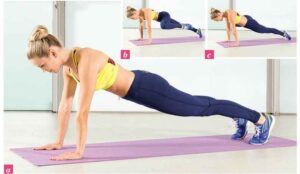Everyone dreams of a firm, toned midsection that feels good and looks great in any outfit. A flat tummy isn’t just about aesthetics; it’s also linked to overall health. Excess belly fat can contribute to various health issues, such as heart problems, diabetes, and poor posture. While achieving a flatter stomach isn’t always easy, a combination of lifestyle tweaks and targeted exercises can help transform your midsection. Below are eight secret ways to get the flat tummy you desire—no extreme diets or quick fixes necessary.
1. Fine-Tune Your Nutrition

Focus on Whole Foods
Eating a balanced diet is crucial for losing unwanted belly fat. Instead of highly processed or sugary foods, opt for whole foods such as fruits, vegetables, lean proteins, whole grains, and healthy fats (like those found in avocados and nuts). These foods are nutrient-dense and keep you feeling full for longer, reducing the likelihood of overeating.
Reduce Refined Carbohydrates
Refined carbohydrates, like white bread and sugary snacks, can spike your insulin levels and encourage fat storage. Replacing these with complex carbs—oats, brown rice, quinoa, and whole grain bread—will stabilize your blood sugar and provide lasting energy.
Portion Control
Even healthy foods can lead to weight gain when consumed in large portions. To ensure you’re not overeating, pay attention to portion sizes. One strategy is using smaller plates and bowls, which naturally limits the amount of food you serve yourself.
2. Stay Hydrated (But Don’t Overdo It)
Water is a key player in digestion and weight management. When you’re well-hydrated, your body can efficiently break down food, absorb nutrients, and eliminate toxins. Inadequate hydration can slow down these processes, contributing to bloating and discomfort.

However, drinking excessive amounts of water during meals may dilute digestive enzymes, making it harder for your body to break down food. A general rule of thumb is to drink a glass of water about 30 minutes before meals to reduce the likelihood of overeating and bloating. Sip water throughout the day to stay hydrated, but avoid chugging large amounts right before or during meals.
3. Incorporate Targeted Abdominal Exercises
Planks

Planks are a fantastic core exercise because they target multiple muscle groups simultaneously, including the transverse abdominis (the muscle responsible for pulling your stomach inward). Aim for three sets of 30- to 60-second planks each day. If you’re a beginner, start on your knees and gradually work your way up to a full plank.
Bicycle Crunches
Bicycle crunches engage the rectus abdominis and obliques, making them effective for sculpting the waistline. Perform these with proper form—keep your lower back pressed into the floor, and move slowly to avoid neck strain. Try three sets of 15-20 reps on each side.
Leg Raises
Leg raises primarily target the lower abs, an area that often stores stubborn fat. To do leg raises properly, lie flat on your back with your hands by your sides or underneath your lower back for support. Slowly lift your legs to a 90-degree angle, then lower them just above the ground. Repeat for 10-15 reps.
4. Focus on Core Strength, Not Just Crunches

While crunches can help tighten the abdominal muscles, relying on them alone won’t necessarily give you a flat stomach. Your core comprises several muscle groups, including the obliques, transverse abdominis, and lower back muscles. By incorporating a variety of moves—like side planks, back extensions, and stability ball exercises—you’ll develop a stronger, more balanced core. This balance helps improve posture, making your tummy appear flatter and reducing strain on your spine.
5. Manage Stress Levels

Stress triggers the release of cortisol, a hormone that can promote abdominal fat storage. Chronic stress and anxiety can also lead to emotional eating, poor sleep, and a lack of motivation for exercise—all factors that undermine efforts to flatten your stomach.
Mindful Practices
Techniques like deep breathing, meditation, and yoga can help calm your mind and lower cortisol levels. Try to spend even just 10 minutes a day practicing mindfulness. This can significantly impact your ability to manage stress and keep belly fat at bay.
Adequate Sleep
Aim for seven to nine hours of quality sleep each night. Poor sleep can increase levels of ghrelin (the hunger hormone) and decrease leptin (the satiety hormone), leading to overeating and weight gain around the midsection.
6. Limit Bloating Triggers
Bloating can sabotage even the healthiest diet by making your stomach look more prominent. Some common culprits include carbonated drinks, excessive salt, and certain high-fiber foods. While fiber is essential for digestive health, too much fiber too quickly can lead to gas and bloating.

- Avoid Fizzy Drinks: The bubbles in carbonated beverages can trap gas in your stomach, causing a puffy midsection. If you crave flavor in your drinks, try infusing water with fresh fruits or herbs.
- Reduce Sodium Intake: High sodium levels cause your body to retain water, which often shows up around the abdominal area. Checking labels and choosing lower-sodium options can help.
- Monitor High-Fiber Foods: Foods like beans, lentils, broccoli, and kale are nutrient-rich but may cause bloating if you’re not used to them. Increase fiber gradually and pair them with plenty of water.
7. Add High-Intensity Interval Training (HIIT) to Your Routine

When it comes to fat burning, high-intensity interval training (HIIT) is one of the most efficient methods. HIIT workouts alternate between short bursts of intense activity and brief recovery periods. For example, you can sprint for 20 seconds, then walk for 40 seconds, repeating the cycle for 10-15 minutes.
This form of exercise boosts your metabolism, leading to increased calorie burn even after you’ve finished exercising. Adding two to three HIIT sessions per week—along with moderate-intensity workouts like brisk walking, cycling, or swimming—can significantly reduce belly fat.
8. Consistency and a Positive Mindset

The final (and perhaps most important) secret is maintaining consistency and a positive outlook. Lasting change doesn’t happen overnight. It takes dedication to healthy eating, regular exercise, and stress management. Celebrate small victories, whether that’s doing one more plank than last time or choosing a healthy snack instead of reaching for junk food.
A positive mindset goes a long way in helping you stay motivated. Rather than fixating on the number on the scale, focus on how your body feels, the energy you have throughout the day, and the improvements in your fitness levels. This shift in perspective keeps you from getting discouraged and helps establish healthier long-term habits.
Conclusion
Achieving a flatter tummy isn’t just about endless crunches or punishing diets. It requires a holistic approach that includes balanced nutrition, targeted exercises, stress management, and consistent routine adjustments. By focusing on whole, unprocessed foods, staying hydrated, incorporating core-strengthening exercises, and allowing your body enough rest and recovery, you’ll be well on your way to the flat stomach you’ve always desired.
Above all, remember to be patient with yourself. Genuine, lasting results don’t happen overnight. Keep these eight secret tips in mind as you go about your daily routine, and you’ll gradually notice a tighter, stronger, and flatter midsection. With the right mindset and consistent effort, you can confidently work toward the flat tummy of your dreams while improving your overall health and well-being.
Disclaimer: This article is for informational purposes only and should not replace professional medical advice. Consult with a healthcare professional before starting any new diet or exercise program.
